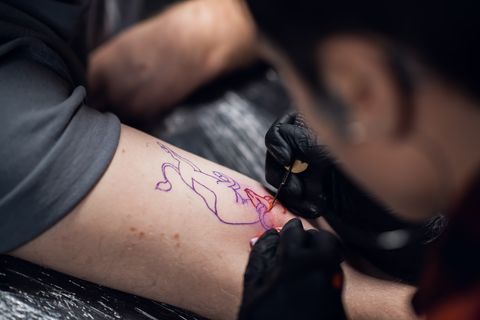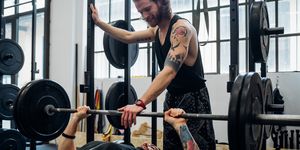DIY Stick and Poke Tattooing Is More Popular Than Ever. Here’s What You Need to Know.
What was the wildest thing you did in the throes of pandemic-induced boredom? My adventures escalated from buzzing my hair and filming workouts with my dog (reasonable) to piercing my ear, busting my face open (twice), then finally giving myself a tattoo (decidedly less reasonable).
The precautions caused by the Covid-19 pandemic might not wind up inspiring some quarantined artist to write the next King Lear, but might help to further popularize DIY manual tattooing (often called “stick and poke” or “hand poke” tattooing) with a wide new audience. The practice is simple: the artist uses a needle to poke ink into the skin to create designs. Body modification practices like this have existed in nearly every culture around the world for millennia, but the dominant form of tattooing in the U.S. is done with machines, a much more recent innovation. But as social has helped to popularize and demystify tattooing for wider audiences and more people decide that they want to pick up a needle and ink to stave off boredom and express themselves on their bodies, it’s imperative that they have access to the right information to keep their practice as safe as possible.
“People have always tattooed themselves at home in some form or another,” says Brooklyn-based artist Josh Arseneau, who practices tattooing with a machine. “The primary concern is cross contamination and exposure to bloodborne pathogens.”
And while Aresenau acknowledges that people can and do safely tattoo themselves at home, the quality of the art is an entirely different matter (and he does clarify that “good” is subjective). “I’ve just booked an appointment to cover up a homemade hand poke job,” he says. “It’s good for business.”
Getting Started With DIY Tattoos at Home
Still, people will continue to do things that aren’t exactly safe or conventional, no matter their circumstances. I’m one of those tattoo-curious people. I got a small last-minute piece at my local shop just before businesses closed their doors in New York City in March 2020, since I knew that the bigger project I had scheduled later that month with a popular artist might wind up getting cancelled (it was). I waited until the shop opened back up in July to make up that appointment—but not everyone was willing to be so patient.
“I started doing stick and pokes on myself because I was unbelievably bored and I missed tattoo shops so badly,” says Kelsey McKinney, a novelist and co-owner of Defector.com who lives in Washington, D.C. McKinney has now tattooed three pieces on herself and one on her spouse, all since the pandemic began last year.
Although she went to art school and bought supplies for tattooing before the coronavirus closed shops across the country, McKinney had no formal training before she started poking during quarantine. She watched some tutorial videos on YouTube, and admits to just working out her process “by feel”. “I know this has probably given me bad habits that would make any professional wince, but I’m not trying to be a professional,” she says. “I’m trying to have a little fun. I also did talk to a doctor about sterilization practices, and only use individually pre-sterilized needles.”
For others, the period served as an opportunity to hone skills they had begun developing ahead of lockdown. Bryan, a freelance journalist who preferred not to share his last name, started practicing hand poke tattooing with his girlfriend in late 2019. Once the pandemic hit, he used the opportunity to expand his practice. He did this in a way that we definitely don’t endorse, giving people he knew from local mutual aid work tattoos, finishing 20 pieces. (You need a permit in New York to be a tattoo artist, but he did not charge money in exchange for his work. For other states’ standards, check with the local Department of Health regulations.)
Bryan also depended on YouTube videos and blog posts he could find online for guidance, but he had some more formal instruction, too. That came from a Brooklyn-based hand poke tattoo artist who works under the Instagram handle @alienqueer, who was offering tutorials over Zoom during the early months of the pandemic. The couple took the class “just so that we were like, absolutely sure we’re not fucking this up,” Bryan says.
What a Hand Poke Tattoo Artist Thinks About DIY Work
That tattoo artist, who goes by the name Mariquita, had the idea for the Zoom sessions once the Covid-19 lockdown started and they couldn’t tattoo clients. “I wanted it to be a very DIY class for which no experience was needed and anyone who was interested could participate,” they said. Even so, they came prepared; Mariquita made a syllabus divided into three one-hour classes, developed a DIY tattoo kit with all the essential supplies and shipped the kits to students ahead of classes, and offered a sliding scale for tuition to help to make the course accessible to a wide audience. Mariquita says they have tattooed for five years and are self-taught.
https://www.instagram.com/p/CN-KYYzDbk4/
A post shared by Mariquita | AQT 👽 (@alienqueertattoo)
“I was nervous about how it would come out being an online workshop, but it worked better than I expected,” they said. “The feedback was great, people were super happy about it and I was surprised to see such good first tattoos people were doing on themselves. I don’t think this would have come to my mind if it wasn’t for the lockdown circumstances, but now I think I’d like to do IRL classes in the future.”
To do a safe DIY tattoo, Mariquita suggests that people have a few items on-hand:
They also recommend watching YouTube tutorials to brush up on techniques and best practices for sterilization (if you’re not planning to enroll in their virtual workshops, of course). Finally, you should have somewhere to dispose of your materials safely—find a sharps container for the needles, and clearly mark the rest as a biohazard before disposal.
Using a DIY Tattoo Kit
When I finally decided I wanted to tattoo myself, I was nervous about getting the right gear. I’ve been getting tattooed in shops for over a decade, but taking up the needle myself was an entirely different matter. Rather than guessing exactly what supplies might work for me, I turned to a ready-made DIY set from Stick and Poke Tattoo Kit after watching several professional-looking YouTube videos produced by the company. I got the basic package, which had just about everything in Mariquita’s list, plus stencil paper for designs and aftercare ointment.
I was able to give myself a serviceable first tattoo using the kit. I stuck to a simple design, a word in Morse code, and poked it along my collarbone. The feeling was much less intense than getting work done with a machine; rather than someone else using a motor to jab a needle into me hundreds of times per minute, I controlled the pace. Where I might describe a machine tattoo as feeling like a constant bee sting, I would liken the hand poke to a quick puncture from a flower’s thorn. The act of self-modification was meditative, and all the more meaningful to me.
https://www.instagram.com/p/CMcXVcsh-62/
A post shared by Brett Williams (@bdwilliams910)
The kit company’s founder, who goes by the name West, says that their business’ guiding principle is harm reduction, a concept most often applied to programs like needle exchanges that serve people who use drugs. The idea is simple: People are going to do things that have potential to harm themselves, so give them access to the supplies they need to do those things as safely as possible without stigma. In this case, that means packaging clean needles, tattoo gear, and a clear set of best practice instructions together so people don’t reach for used sewing supplies and India ink without any knowledge of good sterilization practices.
West is also quick to talk about the DIY community they’ve become part of through the business and its focus on self-modification. The art of tattooing is more than just decorative here—it’s self-affirming for people who are commonly marginalized in other spaces. “Customers have turned [DIY tattooing] into what they believe it is for themselves, which is reclaiming their body, doing body art on themselves as a way to reclaim and to create something on themselves,” West says. “I think the pandemic with not being able to go to a tattoo artist, not being able to go out and be creative—people were wanting to be creative at home with their own bodies.” West also cites hand poke artist Tann, who runs the Instagram account Ink the Diaspora, as a major source for their education on hand poke tattooing, especially for people with dark skin tones, which can be a contentious topic in the mainstream tattoo world.
DIY Tattoos Post-Pandemic
For some people, hand poke tattooing will be just another hobby they leave behind after the most stringent public health restrictions are lifted and “normal” life resumes. But for others, like members of the DIY community, the practice will never go away. For Bryan, stick and poke was a stepping stone to getting a tattoo machine, so he could take on more complicated designs and finish them faster.
“So what does it matter really, if my self-done tattoo doesn’t look perfect?”
Regardless of their commitment to the practice of tattooing, anyone who dabbled during the pandemic will have a permanent memento. Some of these pieces will look great for years; others will be messy and need appointments with pro artists like Arseneau to bring them to their fullest potential. But McKinney thinks that the imperfections of her quarantine hobby are exactly what makes them worthy of a place on her body. After all, they’re a part of her now—and if Covid-19 has taught us anything, it is that our lifespans are unpredictable and finite.
“It’s kind of silly but one of my favorite tattoo artists Mira Mariah said something a couple of years ago about how actually tattoos are the most temporary form of art,” says McKinney. “Our bodies die and decay far faster than a canvas or a hunk of marble. So what does it matter really, if my self-done tattoo doesn’t look perfect?”
Source: Read Full Article


